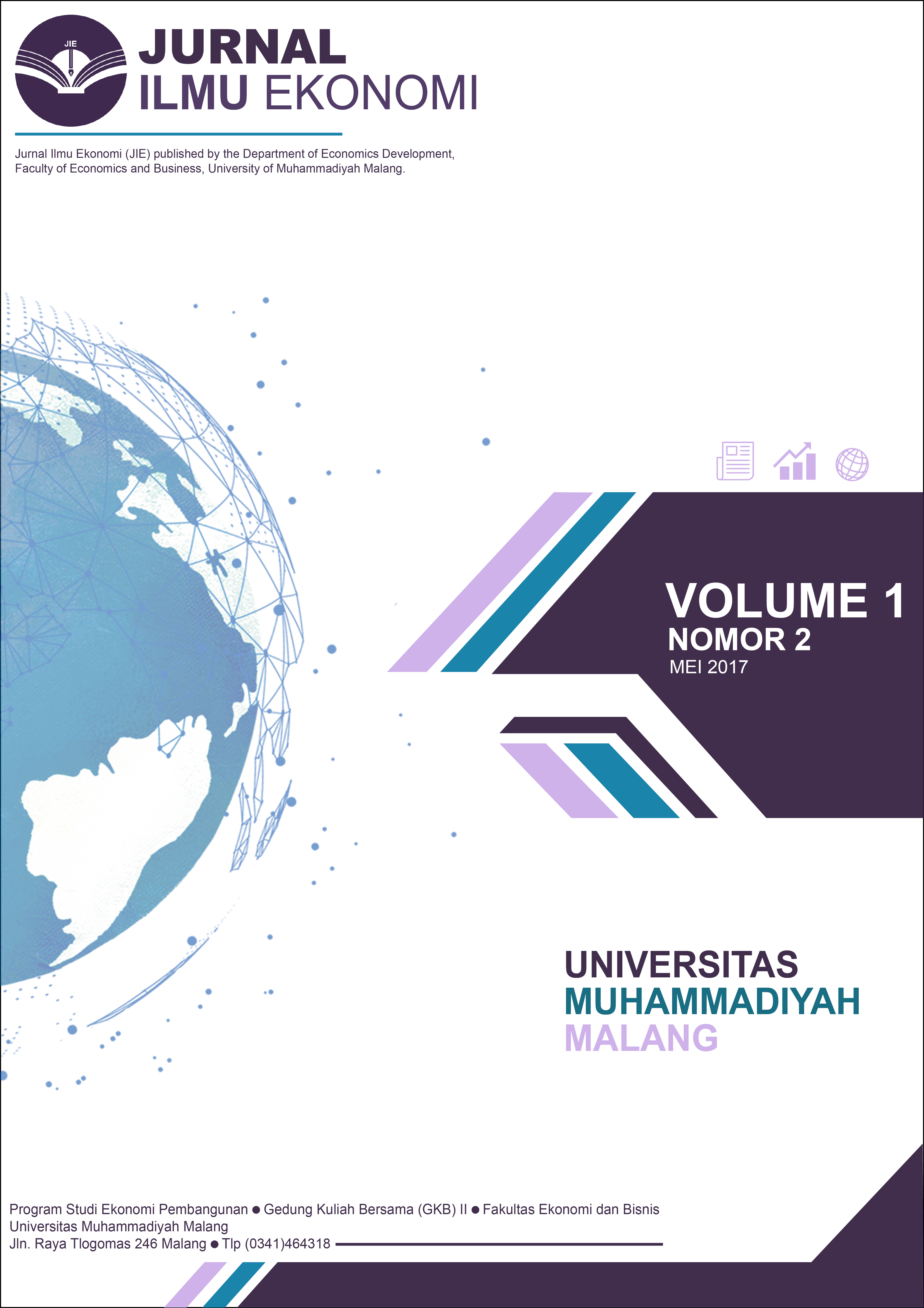ANALISIS PENGARUH SUKU BUNGA SERTIFIKAT BANK INDONESIA DAN JUMLAH UANG BEREDAR TERHADAP TINGKAT INFLASI DI INDONESIA PERIODE 2006.12015.12 (PENDEKATAN ERROR CORRECTION MODEL)
DOI:
https://doi.org/10.22219/jie.v1i2.6148Abstract
Abstract Prominent characteristics of the direction economic policy in Asia is the emphasis on the inflation rate. Inflation is defined as a condition increases the price of prevailing goods in an economy continuously. The purpose of this research is to find out and analyze the influence of Bank Indonesia Certificate interest rate and money supply toward the inflation rate in Indonesia. This research method using time series of monthly data during the period of the 2006.1-2015.12 model approach using error correction (ECM) in the long term or short term. The results of the estimation of cointegration equation indicate that on the long run variable Bank Indonesia Certificate interest rate and money supply is significantly effected by to the inflation rate in Indonesia. While ECM model is considered valid because the error correction term (ECT) has significant value. In the short term only Bank Indonesia Certificate interest rates that influence significantly to the inflation rate in Indonesia. Keywords: inflation, interest rates, money supply, error correction model
Downloads
References
Detri, K., & Syamsuddin, S. (2016). Makro Ekonomi Pengantar Untuk Manajemen. Jakarta: PT RajaGrafindo Persada.
Gujarati, D. N. (2011). Dasar-Dasar Ekonometrika. (S. Empat, Ed.). jakarta. Heru, P. (2010). Analisis Pengaruh Jumlah Uang Beredar, Suku Bunga SBI, Nilai Tukar Terhadap Tingkat Inflasi. Media Ekonomi, 19, 1–19. Judisseno K Rimsky. (2002). Sistem Moneter dan Perbankan Di Indonesia. Jakarta: PT Gramedia Pustaka Utama. Langi, T. M., Masinambow, V., & Siwu, H. (2014). Analisis Pengaruh Suku Bunga BI, Jumlah Uang Beredar, dan Tingkat Kurs Terhadap Tingkat Inflasi Di Indonesia. Jurnal Berkala Ilmiah Efisiensi, 14(2), 44–58. Maggi, R., & Saraswati, B. D. (2013). Faktor-Faktor Yang Mempengaruhi Inflasi Di Indonesia: Model Demand Pull Inflation. Jurnal Ekonomi Kuantitatif Terapan, 6(2), 71–77. Mankiw, N. G. (2007). Macroeconomics (6th ed.). Jakarta: Erlangga. Manurung, M., & Rahardja, P. (2004). Uang, Perbankan, dan Ekonomi Moneter (Kajian Konstektual Indonesia). Jakarta: Penerbitan Fakultas Ekonomi Universitas Indonesia. Murni, A. (2006). Ekonomika Makro. Bandung: PT Refika Aditama. Ningsih, D., & Zuhroh, I. (2010). Analisis Permintaan Kredit Investasi pada Bank Swasta Nasional di Jawa Timur. Jurnal Ekonomi Pembangunan, 8, 345–355. Pohan, A. (2008). Potret Kebijakan Moneter Indonesia: Seberapa Jauh Kebijakan Moneter Mewarnai Perekonomian Indonesia. Jakarta: PT Raja Grafindo Persada. Rosadi, D. (2012). Ekonometrika dan Analisis Data Runtun Waktu dan Terapan dengan Eviews. Yogyakarta: Penerbit ANDI. Soeratno. (2004). Ekonomi Makro Pengantar. Yogyakarta: Bagian Penerbitan Sekolah Tinggi Ilmu Ekonomi YKPN Yogyakarta. Sukirno, S. (2010). Makroekonomi Teori Pengantar. Jakarta: PT RajaGrafindo Persada. Wahyuningsih, D., Zuhroh, I., & Zainuri. (2008). Prediksi Inflasi Indonesia Dengan Model Artificial Neural Network. Journal of Indonesian Applied Economics, 2, 113–127.
Downloads
Published
How to Cite
Issue
Section
License
Copyright (c) 2018 Jurnal Ilmu EKonomi JIE

This work is licensed under a Creative Commons Attribution-ShareAlike 4.0 International License.
Authors who publish with this journal agree to the following terms:
- For all articles published in the JIE (Jurnal Ilmu Ekonomi), copyright is retained by the authors. Authors give permission to the publisher to announce the work with conditions. When the manuscript is accepted for publication, the authors agree to the automatic transfer of non-exclusive publishing rights to the publisher.
- Authors retain copyright and grant the journal right of first publication with the work simultaneously licensed under a Creative Commons Attribution-NonCommercial-ShareAlike 4.0 International License that allows others to share the work with an acknowledgement of the work's authorship and initial publication in this journal.
- Authors are able to enter into separate, additional contractual arrangements for the non-exclusive distribution of the journal's published version of the work (e.g., post it to an institutional repository or publish it in a book), with an acknowledgement of its initial publication in this journal.
- Authors are permitted and encouraged to post their work online (e.g., in institutional repositories or on their website) prior to and during the submission process, as it can lead to productive exchanges, as well as earlier and greater citation of published work (See The Effect of Open Access).
This is an open access article and licensed under a Creative Commons Attribution-NonCommercial-ShareAlike 4.0 International License








